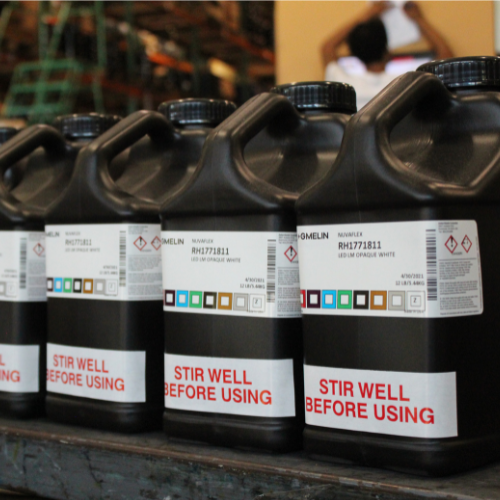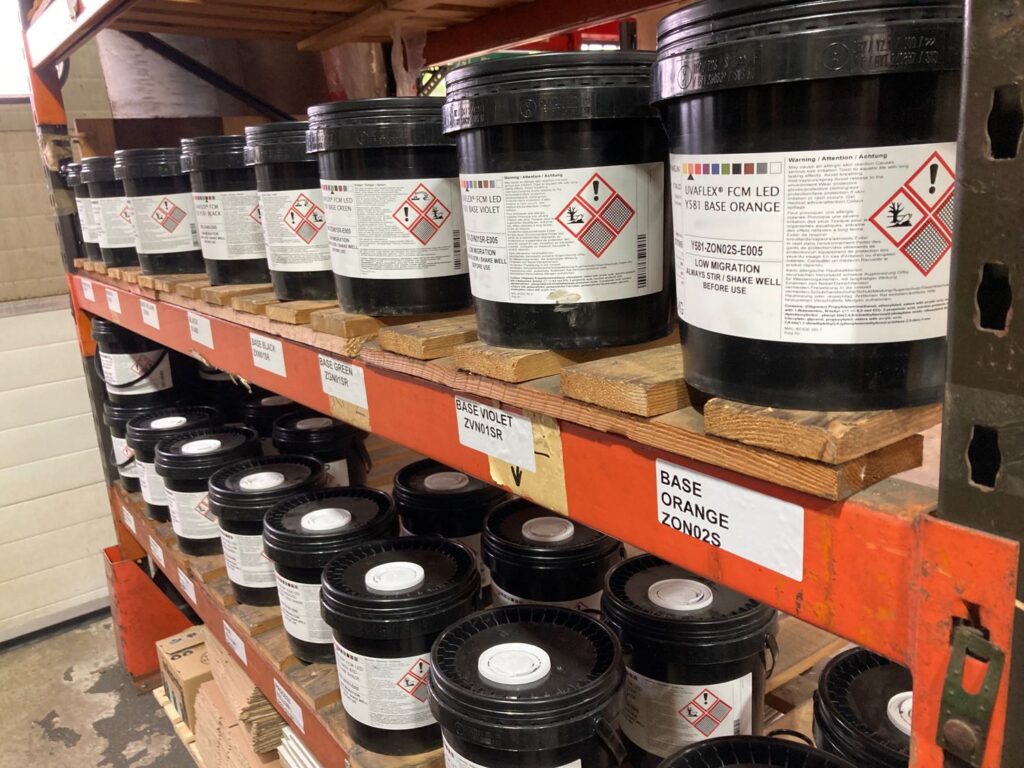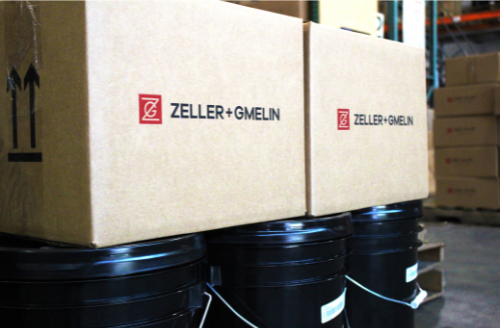Ink Management – Setting up Your Ink Room for Success
Ink management is an important factor for running a seamless and productive printing operation. Without a well-organized system, pressroom managers risk production delays, increased costs, and compromised quality.
As a leader in UV ink solutions, Zeller+Gmelin has provided this guide to help you avoid common mistakes and adopt best practices for managing your printing ink inventory.
The Importance of Ink Inventory Management
Raw material mismanagement causes a host of pain points for industrial printing operations. As one of the highest cost consumables and a driving factor for print quality, ink management is especially important to maintain profitability and customer satisfaction.
Effective inventory management ensures high quality inks are available when needed, helping you avoid downtime and expedited shipping costs and improve material utilization. Plus, a reliable ink supply supports on-time order delivery and consistent print quality.
Common Pitfalls in Ink Management
Knowing the risks of inventory mismanagement is the first step, avoiding these common mistakes is the next. Zeller+Gmelin is a leading provider of printing inks for flexo, offset and commercial applications. With over 150 years in the business, here’s some of the common inventory mishaps we’ve seen that affect printers’ bottom lines.
Overstocking or Understocking: Excess inventory ties up capital and risks obsolescence, especially with UV/LED inks which have a shorter shelf life than others. While understocking can lead to production delays and expedited shipping costs, reducing your profit margins and productivity.
Inadequate Rotation: Failure to rotate your inventory and follow the FIFO (First In, First Out) method is a leading cause of ink expiration. Using expired ink may result in improper curing or adhesion and color inconsistency.
Improper Labeling: Mislabeling or lack of tracking, leads to confusion about ink age, type, or intended use. Poor label practices could increase the likelihood of accidental use of expired or incorrect inks as well as cause delays in production to find the right inks or resolve labeling issues.
Lack of Usage Monitoring: Not keeping accurate usage data can result in inaccurate forecasting and missed opportunities to optimize ink ordering. Profit margins dip when expedited shipping is needed to produce an order on time.
Poor Container Sealing or Storage: Open or improperly sealed containers can lead to contamination, drying, or curing of inks. Be aware of incorrect temperature, humidity, or exposure to light. These factors can degrade the ink over time or cause premature curing resulting in more ink waste.
Without a proper ink management system in place, these inventory mistakes can negatively impact your daily operations and may be the culprit of low profit margins affecting your bottom line.
Z+G Inventory Tips for Success
Avoiding common inventory issues doesn’t require complex methods, you can start with simple improvements that make a big impact. These tips from our team of experts are actionable steps that you can take in your ink room.
Use an Inventory Management System: Implement software to track ink inventory levels, expiration dates, and usage trends. This can be as easy as a spreadsheet or software on a dispenser. More advanced tracking software can integrate with your production schedule and equipment, such as automated dispensers with built-in tracking sensors for ink usage monitoring in real time.
Adopt FIFO Practices: Standardize your ink receiving process to always rotate the oldest inventory to the front and place newer products behind, following the FIFO method to reduce waste. Confirm expiration dates when rotating to ensure the inks expiring first are easily accessible.
Standardize and Label Clearly: Label all containers with batch numbers, production dates, and expiration dates. Use color-coded systems for quick identification between ink types or applications. Using QR codes, barcodes or RFID tagging can make stock tracking more efficient and reduce manual errors. Periodically, inspect labels to make sure important information is not worn or torn off – relabel as needed.
Set Minimum and Maximum Thresholds: To maintain balance, define reorder points and maximum stock levels for each ink type. Use consumption data from your tracking system, set up automated alerts in your software, and take note of supplier lead times to optimize this component of ink management.
Dispose of Expired Inks Safely: Create standard operating procedures related to the disposal of each ink type used in your pressroom, to ensure environmental and employee safety. Incorrect disposal of expired inks can harm the environment and increase disposal costs, not to mention that failure to correctly manage hazardous materials can result in fines or legal issues.
Conduct Regular Training: Train staff on proper handling, storage, and inventory practices for UV/LED inks to minimize human error. Establish clear protocols for leaks, contamination and light exposure to effectively address potential storage issues and/or safety concerns. Standardize these ink management processes in written format and incorporate them into your onboarding programs for all applicable employees.
The Importance of Regular Audits
Conducting ink inventory audits at regular intervals is another way to prevent issues like overstocking, misidentified, and expired inks. We recommend creating a schedule or checklist to standardize the process.
For larger operations with significant ink usage (over 20,000lbs/month), monthly audits ensure that your inventory remains manageable and optimized. Smaller printers with stable usage patterns can typically operate on a quarterly audit schedule to maintain order.
Spot audits are good practice when discrepancies are expected or after significant events like an ink room move or a new press install. Operations of all sizes should consider annual comprehensive reviews to reconcile inventory data with physical stock and to review supplier performance.
Ink Storage Best Practices
Protect your ink quality with this checklist for storage best practices.
Control the Environment: Maintain appropriate temperature and humidity based on ink type. UV inks require cool, dark storage, ideally between 60°F–77°F (15°C–25°C) to prevent premature curing. Whereas, water-based inks need protection from freezing, which can break down their formulation and render the ink unusable. Humidity can cause some inks to thicken or separate, as well as increase the risk of microbial contamination in water-based inks.
Maintain Proper Seals: Use airtight lids and reseal containers completely and immediately after use to prevent contamination or curing. Inspect seals for wear and tear during your audits and replace any damaged lids or gaskets promptly.
Store Away from Direct Light and Heat: UV-sensitive inks and coatings can cure or degrade with exposure. Make sure UV/LED inks are stored in opaque containers and stored away from direct sunlight or artificial light.
Check Condition Regularly: Inspect containers for leaks, rust, or swelling, and take immediate action if found. Swelling of containers can indicate contamination or chemical reactions within the ink and should be addressed immediately. Log your inspections and analyze the data for recurring issues or trends in deterioration.
Segregate Storage: Store inks by type (UV, solvent-based, water-based) and label the areas clearly to avoid cross-contamination. Store inks used for specific applications, such as specialty or food-safe inks separate from your general use inks. Also be sure to create a clearly marked “waste inks” area for any products that need to be disposed of according to regulatory guidelines.
Proactive ink management will lead to smoother operations and ultimate cost savings for you, and better quality for your customers. Get started today with Zeller+Gmelin to avoid production delays, improve production efficiency, and maintain regulatory compliance.
Ready to optimize your ink room setup? Our team can help with auditing your current inventory and providing recommendations for improvement. Contact the Zeller+Gmelin team for ink and coating solutions, expertly done.



